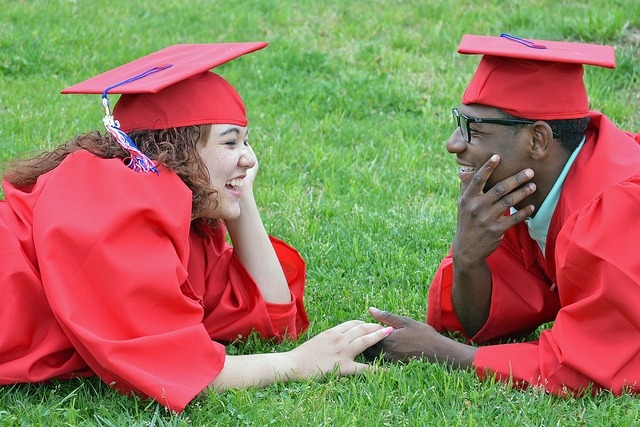
In higher education, admissions and alumni relations are often viewed as two separate departments operating at opposite ends of the student’s lifecycle. At the front end, admissions officers recruit new students to the university, accompany them throughout the application process and get them ready to start going to class. Alumni relations, on the other hand, begin working with students just as they finish their studies, keeping them engaged, concerned and active with their alma mater. So what can admissions and alumni relations possibly have in common?
Alumni relations generally aspire to one of two results: engagement or development. Engagement encompasses all the ways in which alumni remain connected to the university after graduation, both in terms of activities (attending events, volunteering, responding and interacting) and emotionally (feeling proud, involved and part of the university community). Development refers to the concrete ways in which alumni help the university grow and advance: making financial donations, facilitating partnerships and identifying sponsors, for example. The two are intrinsically linked, since engaging alumni is a pre-requisite to obtaining their support for development projects.
In the United States, where alumni relations has become ingrained in the culture and matured as a profession for over a century, universities direct much of their fundraising activities at alumni, who represent a significant source of revenue. In Europe, however, most alumni relations offices focus on engagement. While many European schools accept donations from alumni, they do not run fundraising campaigns targeted at this group. In a survey of European universities, promoting the institution was by far the most important benefit attributed to alumni relations, with the recruitment of new undergraduate and graduate students also earning top marks. Interestingly, these same goals are shared by another department: admissions.
An integrated structure
Structurally, alumni relations and admissions departments have much in common. In the US context, following a model that emerged in the 1970s at East Coast schools, admissions offices were starting to be integrated into a larger definition of enrollment management. In an effort to rationalize the workload, streamline processes and share information, different functions related to enrollment were grouped under one roof: market research, outreach and recruitment of new students, applications, data processing, record keeping, matriculations and registrations, as well as benchmarking and performance measurement.
Successful alumni relations offices are organized along a similar model, integrating the functions of data management, prospect acquisition, record keeping, outreach activities and, in some cases, fundraising. For both admissions and alumni relations, this integrated approach can lead to improved processes where information is shared and performance increases.
A seamless experience for students
What would happen if we could take this integration to the next level, not just within these departments but including both of them under the larger scope of enrollment management? “Given the parallels and shared principles between admissions and alumni functions,” says one expert, “it is unfortunate that this vision is almost never realized (except in rare cases) and the offices work separately with limited interaction."

Admissions and alumni offices have much to gain from pulling in the same direction
While admissions is situated at the beginning of the student’s experience and alumni relations at the end, the reality is that the student’s lifecycle is no longer an exclusively linear process with more-or-less fixed start and end dates. The rising popularity of modular online training programs made available by universities, such as MOOCs (Massive Open Online Courses), distance education programs and a variety of hybrid models means that alumni are encouraged to return to the university for additional training, passing once again through admissions. The once straight line from applicant to alumnus is now becoming a circular, or even spiral, continuum. The vision of life-long learning is closer now to becoming a reality than in the past. This new reality calls for increased collaboration.
A collaborative model
Breaking down the silos would permit more collaboration across different parts of the university, which is by its very nature a large, complex organization with many units and branches –some better funded than others. According to Serge Sych, Director of Alumni and Corporate Relations at Central European University in Hungary, “The best way to go about alumni relations in the context of the so-called ‘small-shop’ operation is the integrated approach, i.e. capitalising on internal institutional resources based on client group overlap and cross-functional activities." Alumni relations share a number of stakeholders with other departments and all would benefit from sharing resources.
Marie worked at the career services office of a Swiss university from 2008 to 2012. While the main customers of the office were enrolled students, Marie remembers specific services provided to alumni: “We surveyed the employment market and published listings of job vacancies for alumni; we organized workshops for them and ran a specialized mentorship program for students up to two years after graduation,” she recalls. “The alumni relations department did not have employment specialists on its staff,” she explains. “We contributed our expertise and capitalized on work we were already doing for enrolled students. It was a win-win arrangement.”
Spreading the word
There are countless other opportunities for collaboration: alumni can coach current students on job strategies; admissions representatives might include alumni meetings in their international recruitment travel schedule; alumni can open doors to research projects and university-industry partnerships. Similar synergies exist in the role alumni can play in recruiting qualified new students, promoting the university “brand” and building its reputation. All the more so, it seems, when alumni relations work hand-in-hand with the international office: “Many alumni relations programs in Europe,” says Mr. Sych, “focus on the needs of international alumni, whose support in recruitment and marketing is deemed as especially valuable.”
Rebecca, a conference interpreter who has lived in Geneva since 2004, volunteers as an external examiner for Bath University (UK), where she obtained a postgraduate diploma. When interpretation students come from Bath to Geneva, she tries to meet with them, organizes a lunch with other Bath graduates and offers them career advice. GBN asked Rebecca what motivates her to do this. “I do this”, she says, “because graduates of the Bath MA course were so very helpful to me when I started out as a freelance interpreter.” She recalls the benefits of the tight network: “They gave me professional contacts, recommended me for work and gave me moral support and practical advice, so I have always tried to do the same for students and recent graduates”. Rebecca is eager to “pay forward” the help she had received: “I am an ambassador for my universities in that I talk positively about them and recommend them to others. It is great for the universities to have successful graduates as examples in their literature and on websites”, she adds, referring to the powerful alumni testimonials that resonate with prospective students.
 Alumni are indeed the university’s best ambassadors – and this requires that they have some understanding of recruitment goals and are able to convey the university’s image effectively. This, in turn, implies that from their first step at the institution as prospects, applicants, students, and now as graduates, they have been receiving consistent messages and have formed a clear idea of their alma mater’s identity; in other words, their student experience has been consistent all throughout – no small feat for the highly diverse and intricate microcosms that are universities.
Alumni are indeed the university’s best ambassadors – and this requires that they have some understanding of recruitment goals and are able to convey the university’s image effectively. This, in turn, implies that from their first step at the institution as prospects, applicants, students, and now as graduates, they have been receiving consistent messages and have formed a clear idea of their alma mater’s identity; in other words, their student experience has been consistent all throughout – no small feat for the highly diverse and intricate microcosms that are universities.
Recruiting and engaging
The reality is that just like new students, alumni must also be “recruited”:
It is only on paper that graduating students become alumni at commencement. In practice, they must be recruited, cultivated, and nurtured into engaged community members who support the institution (…) A detached alumnus is just a graduate. An engaged alumnus is an ongoing partner and asset.
This is where admissions and alumni relations professionals share a common skill set. Both need to gain a deep understanding of their target audiences (prospective students/graduates) and segment them according to relevant characteristics: academic area of interest; geographic location and language; age; professional interests and situation; personal interests; networks and influencers; etc. They can then use this information to customize their services and outreach activities for each segment, increasing results – which might be measured in terms of “yield” or “engagement”.
Grégory gained a joint Diplôme d’études approfondies in Information Systems from the EPFL and the University of Geneva in 2005. As a young graduate, he was able to obtain a very specific service: “We were just out of school and enthusiastic to open a start-up. The EPFL Alumni Association put us in touch with a service providing legal advice specifically in this area. It helped move our project along. Finding the same advice on our own would have been complicated and much more costly,” he says. For him, the quality of alumni services is measured by their relevance.
Finally, both groups need to master the same set of communication tools: web sites, newsletters, social media, direct (e)mail, events, and much more. They need to control the volume (length, frequency) of information sent, build alliances with effective influencers and help individuals make meaningful connections with the appropriate networks and communities.
Alumni and development officers are often the stewards of the institution’s brand and tellers of the institutional story. They are responsible for sharing the institution’s distinctive message and communicating the brand story in clear and captivating ways. It is essential to connect what the institution is at its core… in order to foster a genuine lifelong relationship. The brand then becomes a narrative that is authentically told, retold, and repeatedly validated.
Substitute “Admissions officers” for “Alumni and development officers” – and the statement holds equally true.
Engagement: a shared strategic objective
The Council for Advancement and Support of Education (CASE), identifies three overriding principles of alumni engagement[x]:
- Respect: Acknowledge alumni as stakeholders, advocate for them, be accountable to them and recognize their contributions;
- Inform: About the mission, goals and programs of the institution, of the alumni association, and ensure the two are aligned;
- Involve: Encourage alumni to participate in the activities, planning and governance of their alumni association and to serve as ambassadors for their university and the greater cause of education.
Admissions and alumni relations have much in common: similar structures, comparable functions and a stake in extending the student experience beyond graduation – seamlessly. The skill sets they require to successfully recruit, engage and communicate are similar. Ultimately, both have the institution’s strategic objectives as their compass and both are accountable for their numbers and the quality of their results. In different ways, both seek to respect, inform and involve their stakeholders. They have much to gain from sharing information, drawing inspiration from one another and collaborating.
Notes:
A study commissioned in 2005 for the European Association of International Education revealed that while over half the 150 universities surveyed accepted donations from their alumni, only 20% ran fundraising campaigns. Azri (www.azri.biz); Petrus Communications (www.petruscommunications.com); EAIE INTAL (www.eaie.org/INTAL): «Alumni Relationship Management in Europe», September 2005.
Ibid
Kurz, Kathy and Scannell, Jim: “Enrollment Management Grows Up” in University Business, May 2006.
“The Strategic Synergy of Alumni Engagement and Enrollment Management”, Maguire Associates, 2009. (17.07.2014)
Sych, Serge: “Alumni relations: cultural and institutional context matters”, EAIE INTAL, September 2012.
Ibid
Maguire, op. cit.
For more on measuring engagement, see King Scully, Maura: “Are We There Yet” in CASE Currents, January 2010.
Maguire, op. cit.
[x]“Principles of Practice for Alumni Relations Professionals at Educational Institutions”, Council for Advancement and Support of Education (CASE). (18.07.2014)
Photo credits
Donald Lee Pardue via photopin cc
nffcnnr via photopin cc
Daryl I via photopin cc




 Alumni are indeed the university’s best ambassadors – and this requires that they have some understanding of recruitment goals and are able to convey the university’s image effectively. This, in turn, implies that from their first step at the institution as prospects, applicants, students, and now as graduates, they have been receiving consistent messages and have formed a clear idea of their alma mater’s identity; in other words, their student experience has been consistent all throughout – no small feat for the highly diverse and intricate microcosms that are universities.
Alumni are indeed the university’s best ambassadors – and this requires that they have some understanding of recruitment goals and are able to convey the university’s image effectively. This, in turn, implies that from their first step at the institution as prospects, applicants, students, and now as graduates, they have been receiving consistent messages and have formed a clear idea of their alma mater’s identity; in other words, their student experience has been consistent all throughout – no small feat for the highly diverse and intricate microcosms that are universities.


Thank you, Michal, for reminding us of the importance of sharing and collaboration instead of competition. This positive attitude is the path for abundance and emotional/physical/professional well being for all.
I have never thought of the two as being so similar. In my mind one (admissions) had to end for the other (alumni) to begin. This article has really brought he relationships between them together in a very seamless way.